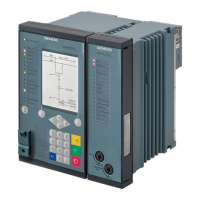Trip-Circuit Supervision with 2 Binary Inputs
In order to recognize disruptions in the trip circuit for each switch position, you need 2 binary inputs. One
input is connected parallel to the respective command relay of the protection, the other parallel to the circuit-
breaker auxiliary contact.
The following figure shows the principle of the trip-circuit supervision with 2 binary inputs.
[dwtcs2be-110611-01.tif, 2, en_US]
Figure 8-28 Principle of Trip-Circuit Supervision with 2 Binary Inputs
CR Command relay
CB Circuit breaker (closed)
CB coil Circuit-breaker coil
AuxCon1 Circuit-breaker auxiliary contact (closed when CB is closed)
AuxCon2 Circuit-breaker auxiliary contact (open when CB is closed)
V-Ctrl Control voltage (tripping voltage)
V-BI1 Input voltage for binary input 1
V-BI2 Input voltage for binary input 2
Supervision with 2 binary inputs identifies disruptions in the trip circuit and the outage of the control voltage.
It also monitors the reaction of the circuit breaker by way of the position of the circuit-breaker auxiliary
contacts.
Depending on the switch position of the command relay and circuit breaker, the binary inputs are either acti-
vated (H) or not (L). If both binary inputs are not activated, there is a fault. The fault may be a interruption or a
short circuit in the trip circuit, an outage of the battery voltage or a fault in the mechanics of the circuit
breaker. With intact trip circuits, this state will occur only briefly while the command relay is closed and the
circuit breaker has not yet been opened.
No
.
Command
Relay
(CR)
CB AuxCon1 AuxCon2 BI 1 BI 2 Dynamic State Static State
1 Open ON Closed Open H L Normal operation with closed circuit
breaker
2 Open OFF Open Closed H H Normal operation with open circuit
breaker
3 Closed ON Closed Open L L Transmission or fault Fault
8.3.11.3
Supervision Functions
8.3 Supervision of the Secondary System
SIPROTEC 5, High-Voltage Bay Controller, Manual 969
C53000-G5040-C015-9, Edition 11.2017

